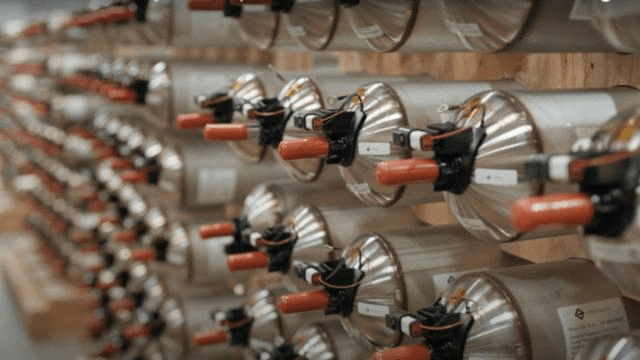RWE, a leading German energy company, is piloting advanced battery technology originally developed by NASA for the International Space Station (ISS). This innovative energy storage solution, designed to enhance renewable energy projects, is being tested at RWE’s Milwaukee testing facility in Wisconsin, where the company plans to integrate nickel-hydrogen batteries into its wind and solar energy systems.
The Energy Storage Vessels (ESVs), provided by EnerVenue, are designed to offer a durable and scalable energy storage solution, capable of enduring over 30,000 charge cycles. This makes them an attractive alternative to traditional lithium-ion batteries, which are increasingly costly and complex to manage at scale. The nickel-hydrogen batteries used in the ESVs store energy in tanks, with a cathode made from nickel hydroxide and an anode relying on hydrogen. The batteries generate hydrogen gas during charging, which is later oxidized to produce water during discharge.

One of the key benefits of this technology is its longevity. Nickel-hydrogen batteries offer an impressive lifespan, retaining 86 percent capacity even after extensive use. These batteries are less prone to the risks associated with thermal runaway, a concern for lithium-ion batteries, and operate without the need for additional cooling or fire suppression systems. Moreover, they function across a wide temperature range (-40°F to 140°F), making them highly adaptable to diverse environmental conditions.
In addition to longevity, ESVs are more environmentally friendly than lithium-ion batteries, as they are easier to recycle, further supporting RWE’s sustainability goals. However, the technology does come with some challenges. Nickel-hydrogen batteries are more expensive to produce and have lower energy density, requiring more units to match the output of lithium-ion systems.
RWE’s pilot project aims to assess several key performance metrics, including energy efficiency, temperature resilience, cycling ability, and charge/discharge performance. The company plans to use the data from these tests to optimize the technology and potentially integrate it into future clean energy projects.
EnerVenue, the company behind the ESVs, was founded following a breakthrough by Yi Cui, a Stanford materials science professor who developed a more affordable nickel-molybdenum-cobalt alloy catalyst to replace the expensive platinum used in earlier designs. This innovation has helped bring nickel-hydrogen technology into commercial use, offering a promising solution for large-scale energy storage.

“Energy Storage Vessels are built to meet the demands of even the most diverse and challenging clean energy applications, providing a reliable, long-lasting, and sustainable answer for large-scale renewable energy projects,” said Majid Keshavarz, CTO of EnerVenue. He emphasized that the partnership with RWE would demonstrate how ESVs can help drive the future of clean energy and enhance grid resilience.
As part of its Growing Green strategy, RWE plans to significantly expand its energy storage capacity, with a target of 6 GW globally by 2030. The company currently operates storage systems in the U.S., Europe, and Australia, with a total capacity of 0.7 GW and another 1.4 GW under construction.


